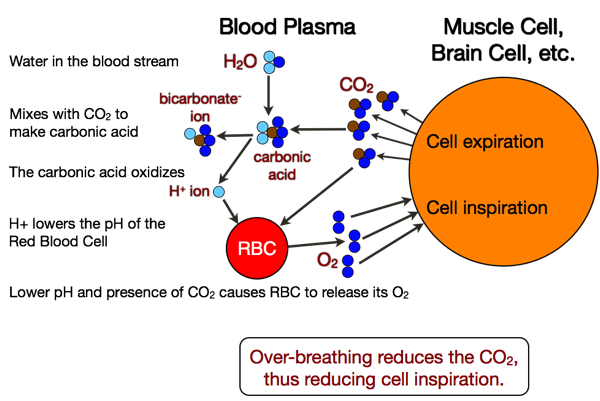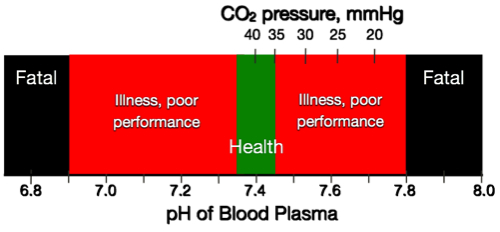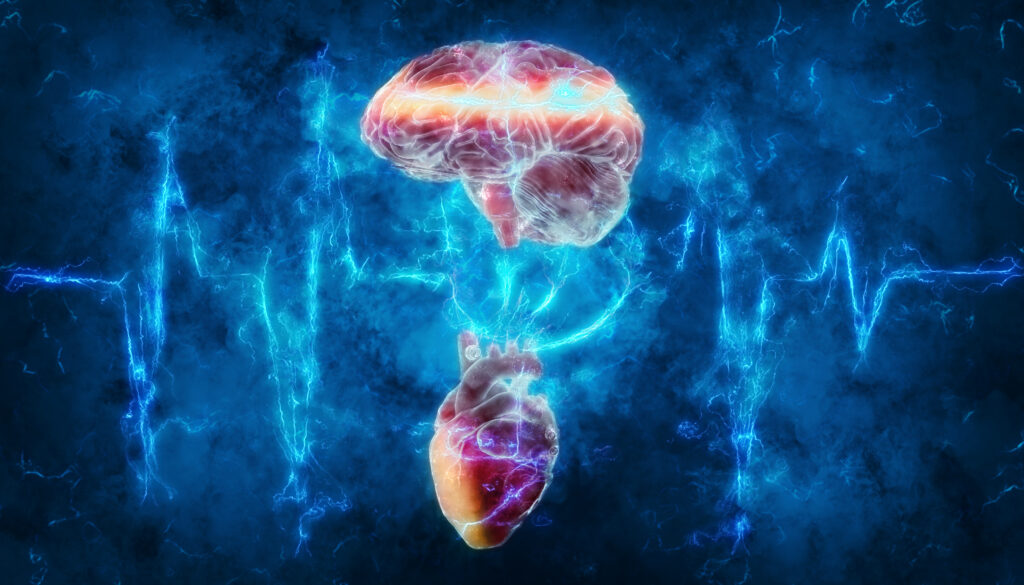Internal and External Respiration
Hypocapnia, also called over-breathing and hyperventilation, is a common, chronic condition that causes a wide variety of illnesses by decreasing the oxygen delivered to tissues. It is a symptom of long-term stress and anxiety and is so common that it is seldom diagnosed. Rapid, shallow breathing becomes habitual and can even persist through breathing exercises. Most meditators don’t realize that the lights and sounds they experience in meditation, and the feelings of calm and detachment, are being caused not by higher consciousness but by oxygen starvation in the brain. Thus meditation is not conducive to better health unless the meditation method is specially designed to overcome Hypocapnia.
Hypocapnia causes deficits of oxygen (hypoxia) and glucose (hypoglycemia) as well as of other required nutrients for the optimal functioning of a wide variety of tissues and physiological systems. By creating a carbon dioxide deficit, over-breathing (hyperventilation) causes cerebral vasoconstriction, coronary constriction, and constriction of other smooth muscles, e.g., in the bronchioles and the gut, thus exacerbating both asthma and arthritis.
Rapid, shallow breathing delivers large amounts of oxygen to the blood stream, and also depletes the blood stream of carbon dioxide. While that might seem to be an optimum formula for high energy and alertness, it actually creates the opposite. There are two parts to the respiration process, called external respiration and internal respiration. In external respiration, oxygen is delivered to the blood stream; in internal respiration, that oxygen is passed from the blood stream to the tissues. If internal respiration is inhibited, the oxygen in the hemoglobin in the Red Blood Cells (RBC) cannot be released and circulates without being used. Internal respiration depends on the presence of carbon dioxide in the blood stream. During over-breathing, the CO2 level is greatly reduced, resulting in oxygen deficits in the brain, heart, muscles, gut and other organs, which causes reduced functioning, cramping, constriction, and pain.
Conscious breath is the key to energy medicine, for breath directs the energy stream wherever attention is placed. By controlling one’s breathing pattern in terms of volume, rate, and inhale-exhale ratio, one can control or directly affect heart rate, heart rate variability, vasodilation, the pH of the blood, oxygenation, blood pressure, metabolic rate, production of stress and anti-stress hormones, immune system triggering and hemisphere dominance. Thus controlling one’s breath pattern is the most effective method for self-regulation.
The breathing pattern taught in Heart Rhythm Meditation is optimized for proper blood chemistry and cardiac health. When one follows the instructions for Heart Rhythm Meditation, proper CO2 levels are guaranteed.
The Details

How does the oxygen carried in the blood stream get delivered to the cells that need it most, and not dumped on cells that are inactive? It’s all controlled by CO2. Any cell that is active, like a muscle cell when you tense it, or a brain cell when you’re alert, gives off CO2: the cell “burns” oxygen, and CO2 is the “smoke”. The CO2 passes out of the cell and into the blood stream where it triggers a series of chemical reactions that affect the passing Red Blood Cells (RBC) to release the oxygen they carry.

Hypocapnia (over-breathing) can cause or aggravate heart palpitations, arrhythmias, mitral valve prolapse, chest pains, weakness and listlessness, muscular stiffness and aching, myalgia, cramps, fibromyostis, muscle spasm, headaches, hyperactivity, seizures, asthma, irritable cough, and shortness of breath.
The pH of the blood must be maintained in a narrow range of 7.35 to 7.45, which is accomplished by keeping the concentration of CO2 in the tidal breath above 35 mmHg, and preferably at 40 mmHg. That depends entirely on the rate and depth of one’s breath.

bove is a computer plot of the CO2 concentration measured in a person’s exhalation. During inhalation, the instrument shows no CO2 because there is no exhalation; the valleys in the plot show inhalation periods. During exhalation, the instrument measures the CO2 and records it; those are the peaks in the graph. For the right pH in the blood stream, the CO2 level must reach 35 mmHg, which this person demonstrates with approx. 7 breaths per minute.

This graph shows the breath slowing to approx. 2 1/2 breaths per minute, while maintaining the ideal CO2 level.
Most people are surprised that the instrument shows they are over-breathing. Unless the CO2 level in one’s breath is measured during breath training, the common fault of over-breathing will not be noticed; only its effects will be noticed, without realizing the cause.




